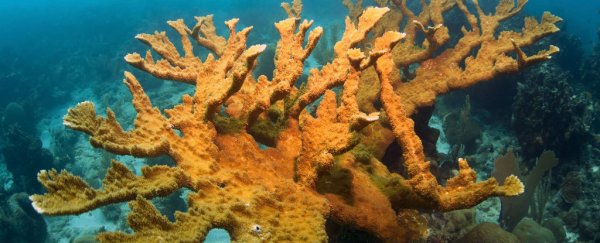For the first time ever, lab-grown Caribbean corals have integrated with wild populations and successfully reproduced, representing the first good news we've heard since the world plunged itself into the third global bleaching event in recorded history.
Scientists have predicted that the damage stemming from this event will affect 38 percent of the planet's reefs, with 12,000 square kilometres expected to die out with the next 12 months. An estimated 80 percent of all Caribbean corals have already disappeared over the last four decades.
In an effort to address this particularly beleagured population, scientists from the international conservation group SECORE (which stands for SExual COral REproduction) have been breeding baby corals in the lab to seed out into the wild.
"In 2011, offspring of the critically endangered elkhorn coral (Acropora palmata) were reared from gametes collected in the field and were outplanted to a reef one year later," said Valerie Chamberland, a coral reef ecologist a SECORE.
Now, just a few years later, the team is seeing the (very exciting) fruits of their labour. "In four years, these branching corals have grown to a size of a soccer ball and reproduced, simultaneously with their natural population, in September 2015," says Chamberland. "This event marks the first ever successful rearing of a threatened Caribbean coral species to its reproductive age."
Elkhorn coral is one of the most distinctive species you'll come across, and this makes it vital to the Caribbean reef it inhabits. Its huge, branching shape - elkhorns grow 5 to 10 cm per year and often reach a diameter of 3.7 metres - not only protects the shore from storm damage, but provides a spacious home for other marine life, such as lobsters and parrotfish.
They're considered one of the most vital reef-building species in the Carribean, but on top of global bleaching events, they're also particularly susceptible to diseases such as the extremely contagious white pox disease, white band disease, and black band disease. The species has been listed as critically endangered since 2008.
While breeding coral in the lab and reintroducing it into the wild might seem fairly straightforward, it's taken the SECORE team years to get it right. What makes their research so exciting is that unlike other teams around the world that are working on reseeding coral populations, SECORE is breeding corals that can actually have a long-term affect on the future of the wild population.
"Most coral conservation efforts involve what's called coral gardening, whereby small fragments of coral and taken and cared for in the lab," Brooks Hays explains over at UPI. "After growing to a healthy size, they are replanted on the reef. This limits the expansion of genetic diversity, as the same gene combinations are added back to the coral community."
The reality is that coral gardening just isn't efficient enough to combat the widespread damage affecting coral right now, but figuring out how to get more breeding individuals out there just might be. We don't have a lot of options left, so let's hope those integrated corals breed like huge, long-branched rabbits.
The research has been published in Global Ecology and Conservation.
